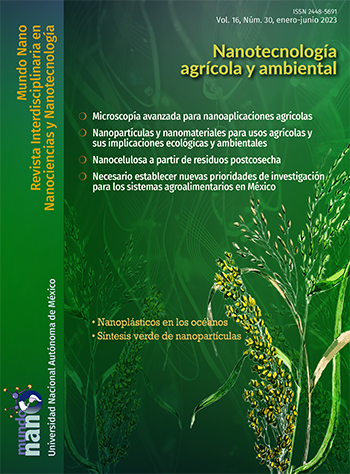Nanopartículas de silicio como vehículos de transporte para moléculas de interés agrícola
Contenido principal del artículo
Resumen
Las nanopartículas de silicio (SiNPs) tienen características intrínsecas que le confieren biocompatibilidad, alta estabilidad química-térmica y amplia área superficial. Esta última cualidad le permite anclar una gran cantidad de moléculas en su superficie, en las cuales se han incluido nucleótidos, proteínas y una diversidad de compuestos químicos con potencial uso en la agricultura. En este contexto, este trabajo describe brevemente aspectos fundamentales sobre las SiNPs, además de presentar una compilación de los últimos trabajos relacionados con el uso de SiNPs y su efecto en diferentes cultivos. Finalmente, se pone en perspectiva un análisis del panorama actual y las capacidades científicas relacionadas con la innovación nanotecnológica enfocadas al sector agrícola del país.
Descargas
Detalles del artículo

Mundo Nano. Revista Interdisciplinaria en Nanociencias y Nanotecnología, editada por la Universidad Nacional Autónoma de México, se distribuye bajo una Licencia Creative Commons Atribución-NoComercial 4.0 Internacional.
Basada en una obra en http://www.mundonano.unam.mx.
Citas
Abdelrahman, T., Qin, X., Li, D., Senosy, I., Mmby, M. y Wan, H. (2021). Pectinase-responsive carriers based on mesoporous silica nanoparticles for improving the translocation and fungicidal activity of prochloraz in rice plants. Chemical Engineering Journal, 404, 126440. https://doi.org/10.1016/j.cej.2020.126440. DOI: https://doi.org/10.1016/j.cej.2020.126440
Angel-Olarte, C., Hernández-Adame, L., Méndez-Blas, A., Palestino, G. (2019). Eu3+/Yb3+ co-doped gadolinium oxysulfide upconverting nanorods: Morphological, physicochemical and optical evaluation. Journal of Alloys and Compounds, 787: 1032-1043. https://doi.org/10.1016/j.jallcom.2019.02.113. DOI: https://doi.org/10.1016/j.jallcom.2019.02.113
Angulo, C., Tello-Olea, M., Reyes-Becerril, M., Monreal-Escalante, E., Hernández-Adame, L., Angulo, M., Mazon-Suastegui, J. M. (2021). Developing oral nanovaccines for fish: A modern trend to fight infectious diseases. Reviews in Aquaculture, 13(3): 1172-1192. https://doi.org/10.1111/raq.12518. DOI: https://doi.org/10.1111/raq.12518
Anzaldo, M. y Chauvet, M. (2016). Technical standards in nanotechnology as an instrument of subordinated governance: Mexico case study. Journal of responsible innovation. 3(2): 135-153. https://doi.org/10.1080/23299460.2016.1196098. DOI: https://doi.org/10.1080/23299460.2016.1196098
Aryadeep, R. (2020). Silicon-nanoparticles in crop improvement and agriculture. International Journal on Recent Advancement in Biotechnology & Nanotechnology, 3(1): 54-65.
Asgari, F., Majd, A., Jonoubi, P., Najafi, F. (2018). Effects of silicon nanoparticles on molecular, chemical, structural and ultrastructural characteristics of oat (Avena sativa L.). Plant Physiology and Biochemistry, 127: 152-160. https://doi.org/10.1016/j.plaphy.2018.03.021. DOI: https://doi.org/10.1016/j.plaphy.2018.03.021
Bilal, M., Xu, C., Cao, L., Zhao, P., Cao, C., Li, F., Huang, Q. (2020). Indoxacarb‐loaded fluorescent mesoporous silica nanoparticles for effective control of Plutella xylostella L. with decreased detoxification enzymes activities. Pest Management Science, 76(11): 3749-3758. https://doi.org/10.1002/ps.5924. DOI: https://doi.org/10.1002/ps.5924
Borda, O., Barón, F., Gómez, M. (2007). Silicon as a beneficial element in forage oat (Avena sativa L.): physiological responses of growth and management. Agronomía Colombiana, 25(2): 273-279.
Buchman, J., Elmer, W., Ma, C., Landy, K., White, J., Haynes, C. (2019). Chitosan-coated mesoporous silica nanoparticle treatment of Citrullus lanatus (watermelon): Enhanced fungal disease suppression and modulated expression of stress-related genes. ACS Sustainable Chemistry & Engineering, 7(24): 19649-19659. https://doi.org/10.1021/acssuschemeng.9b04800. DOI: https://doi.org/10.1021/acssuschemeng.9b04800
Cao, B., Ma, Q., Zhao, Q., Wang, L., Xu, K. (2015). Effects of silicon on absorbed light allocation, antioxidant enzymes and ultrastructure of chloroplasts in tomato leaves under simulated drought stress. Scientia Horticulturae, 194: 53-62. https://doi.org/10.1016/j.scienta.2015.07.037. DOI: https://doi.org/10.1016/j.scienta.2015.07.037
Cao, L., Zhang, H., Cao, C., Zhang, J., Li, F., Huang, Q. (2016). Quaternized chitosan-capped mesoporous silica nanoparticles as nanocarriers for controlled pesticide release. Nanomaterials, 6(7): 126. https://doi.org/10.3390/nano6070126. DOI: https://doi.org/10.3390/nano6070126
Cao, L., Zhang, H., Zhou, Z., Xu, C., Shan, Y., Lin, Y., Huang, Q. (2018). Fluorophore-free luminescent double-shelled hollow mesoporous silica nanoparticles as pesticide delivery vehicles. Nanoscale, 10(43): 20354-20365. https://doi.org/10.1039/C8NR04626C. DOI: https://doi.org/10.1039/C8NR04626C
Cao, L., Zhou, Z., Niu, S., Cao, C., Li, X., Shan, Y., Huang, Q. (2017). Positive-charge functionalized mesoporous silica nanoparticles as nanocarriers for controlled 2,4-dichlorophenoxy acetic acid sodium salt release. Journal of Agricultural and Food Chemistry, 66(26): 6594-6603. https://doi.org/10.1021/acs.jafc.7b01957. DOI: https://doi.org/10.1021/acs.jafc.7b01957
Chen, H., Chen, L., Shen, Z., Zhou, H., Hao, L., Xu, H., Zhou, X. (2020). Synthesis of mesoporous silica post-loaded by methyl eugenol as an environment-friendly slow-release bio pesticide. Scientific Reports, 10(1): 1-12. https://doi.org/10.1038/s41598-020-63015-6. DOI: https://doi.org/10.1038/s41598-020-63015-6
Chen, H., Lin, Y., Zhou, H., Zhou, X., Gong, S., Xu, H. (2016). Synthesis and characterization of chlorpyrifos/copper(II) schiff base mesoporous silica with pH sensitivity for pesticide sustained release. Journal of Agricultural and Food Chemistry, 64(43): 8095-8102. https://doi.org/10.1021/acs.jafc.6b03262. DOI: https://doi.org/10.1021/acs.jafc.6b03262
Chunli, X., Bilal, M., Bo, X., Gangchao, R., Pengyue, Z., Chong, C., Fengmin, L., Lidong, C., Qiliang, H. (2020). Preparation and characterization of prothioconazole-loaded fluorescent mesoporous silica nanoparticles. Chinese Journal of Pesticide Science, 22(2): 214-224. https://doi.org/10.16801/J.ISSN.1008-7303.2020.0046.
Clausen, L. P. W. y Hansen, S. F (2018). The ten decrees of nanomaterials regulations. Nature Nanotech, 13: 766-768. https://doi.org/10.1038/s41565-018-0256-2. DOI: https://doi.org/10.1038/s41565-018-0256-2
Dannon, E., Wydra, K. (2004). Interaction between silicon amendment, bacterial wilt development and phenotype of Ralstonia solanacearum in tomato genotypes. Physiological and Molecular Plant Pathology, 64(5): 233-243. https://doi.org/10.1016/j.pmpp.2004.09.006. DOI: https://doi.org/10.1016/j.pmpp.2004.09.006
Food and Agriculture Organization, FAO (2022). México en una Mirada. https://www.fao.org/mexico/fao-en-mexico/mexico-en-una-mirada/es/.
Feng, J., Chen, W., Shen, Y., Chen, Q., Yang, J., Zhang, M. et al. (2020). Fabrication of abamectin-loaded mesoporous silica nanoparticles by emulsion-solvent evaporation to improve photolysis stability and extend insecticidal activity. Nanotechnology, 31(34): 345705. https://doi.org/10.1088/1361-6528/ab91f0. DOI: https://doi.org/10.1088/1361-6528/ab91f0
Feng, J., Yang, J., Shen, Y., Deng, W., Chen, W., Ma, Y. (2021). Mesoporous silica nanoparticles prepared via a one-pot method for controlled release of abamectin: Properties and applications. Microporous and Mesoporous Materials, 311, 110688. https://doi.org/10.1016/j.micromeso.2020.110688. DOI: https://doi.org/10.1016/j.micromeso.2020.110688
Gad, M., Li, M., Ahmed, F., Almoammar, H. (2020). Nanomaterials for gene delivery and editing in plants: Challenges and future perspective. Multifunctional Hybrid Nanomaterials for Sustainable Agri-Food and Ecosystems, 135-153. https://doi.org/10.1016/B978-0-12-821354-4.00006-6. DOI: https://doi.org/10.1016/B978-0-12-821354-4.00006-6
Gao, Y., Liang, Y., Dong, H., Niu, J., Tang, J., Yang, J. et al. (2020a). A bioresponsive system based on mesoporous organosilica nanoparticles for smart delivery of fungicide in response to pathogen presence. ACS Sustainable Chemistry & Engineering, 8(14): 5716-5723. https://doi.org/10.1021/acssuschemeng.0c00649. DOI: https://doi.org/10.1021/acssuschemeng.0c00649
Gao, Y., Xiao, Y., Mao, K., Qin, X., Zhang, Y., Li, D. et al. (2020b). Thermoresponsive polymer-encapsulated hollow mesoporous silica nanoparticles and their application in insecticide delivery. Chemical Engineering Journal, 383, 123169. https://doi.org/10.1016/j.cej.2019.123169. DOI: https://doi.org/10.1016/j.cej.2019.123169
Gao, Y., Zhang, Y., He, S., Xiao, Y., Qin, X., Zhang, Y., Li, D., Ma, H., You, H., Li, J. (2019). Fabrication of a hollow mesoporous silica hybrid to improve the targeting of a pesticide. Chemical Engineering Journal, 364: 361-369. https://doi.org/10.1016/j.cej.2019.01.105. DOI: https://doi.org/10.1016/j.cej.2019.01.105
Guntamukkala, B. y Pusarla, S. (2017). Silicon uptake, transportation and accumulation in Rice. Journal of Pharmacognosy and Phytochemistry, 6(6): 290-293.
Hansen S. F., Maynard A., Baun A., Tickner, J. A. y Bowman D. M. (2013). Nanotechnology — Early lessons from early warnings. En EEA “Late lessons from early warnings: science, precaution, innovation”. EEA Report No 1/2013: 530-559. https://doi.org/10.2800/70069.
Hernández-Adame, L., Angulo, C., García-Silva, I., Palestino, G., Rosales-Mendoza S. (2019). An overview of nanogel-based vaccines. Expert Review of Vaccines, 18(9): 951-968. https://doi.org/10.1080/14760584.2019.1647783. DOI: https://doi.org/10.1080/14760584.2019.1647783
Hernández-García, Y. I., Anzaldo Montoya, M. (2021). Flow of ideas in the study of communication channels and references in publications on nanotechnology applied to food and agriculture in Mexico. Scientometrics, 126: 995-1017. https://doi.org/10.1007/s11192-020-03793-y. DOI: https://doi.org/10.1007/s11192-020-03793-y
INEGI-Conacyt. (2017). Encuesta sobre investigación y desarrollo tecnológico (ESIDET), indicadores sobre nanotecnología y biotecnología. https://www.inegi.org.mx/programas/esidet/2017/default.html#Tabulados.
Kah, M., Kookana, R. S., Gogos, A. y Bucheli, T. D. (2018). A critical evaluation of nanopesticides and nanofertilizers against their conventional analogues. Nature nanotechnology, 13(8): 677-684. https://doi.org/10.1038/s41565-018-0131-1. DOI: https://doi.org/10.1038/s41565-018-0131-1
Kang, Z., Liu, Y., Lee, S. (2011). Small-sized silicon nanoparticles: new nanolights and nanocatalysts. Nanoscale, 3(3): 777-791. https://doi.org/10.1039/C0NR00559B. DOI: https://doi.org/10.1039/C0NR00559B
Karupannan, S., Dowlath, M., Arunachalam, K. (2020). Phytonanotechnology: Challenges and future perspectives. Phytonanotechnology, 303-322. https://doi.org/10.1016/B978-0-12-822348-2.00015-2. DOI: https://doi.org/10.1016/B978-0-12-822348-2.00015-2
Le, V., Rui, Y., Gui, X., Li, X., Liu, S., Han, Y. (2014). Uptake, transport, distribution and bio-effects of SiO2 nanoparticles in Bt-transgenic cotton. Journal of Nanobiotechnology, 12(1). https://doi.org/10.1186/s12951-014-0050-8. DOI: https://doi.org/10.1186/s12951-014-0050-8
Li, W., Wang, Q., Zhang, F., Shang, H., Bai, S., Sun, J. (2021). pH-sensitive thiamethoxam nanoparticles based on bimodal mesoporous silica for improving insecticidal efficiency. Royal Society Open Science, 8(2). https://doi.org/10.1098/rsos.201967. DOI: https://doi.org/10.1098/rsos.201967
Li, Z., Yingwen, M., Cheng, P., Martin, F., Hua, S., Zhongjun, D. (2021). Understanding the mechanisms of silica nanoparticles for nanomedicine. WIREs Nanomedicine and Nanobiotechnology 13 (1): 1658. https://doi.org/10.1002/wnan.1658. DOI: https://doi.org/10.1002/wnan.1658
Mandlik, R., Thakral, V., Raturi, G., Shinde, S., Nikolić, M., Tripathi, D. (2020). Significance of silicon uptake, transport, and deposition in plants. Journal of Experimental Botany, 71(21): 6703-6718. https://doi.org/10.1093/jxb/eraa301. DOI: https://doi.org/10.1093/jxb/eraa301
Martin-Ortigosa, S., Peterson, D., Valenstein, J., Lin, V., Trewyn, B., Lyznik, L., Wang, K. (2013). Mesoporous silica nanoparticle-mediated intracellular Cre protein delivery for maize genome editing via loxP site excision. Plant Physiology, 164(2): 537-547. https://doi.org/10.1104/pp.113.233650. DOI: https://doi.org/10.1104/pp.113.233650
Mitani, N. (2005). Uptake system of silicon in different plant species. Journal of Experimental Botany, 56(414): 1255-1261. https://doi.org/10.1093/jxb/eri121. DOI: https://doi.org/10.1093/jxb/eri121
Moraes, J., Goussain, M., Carvalho, G., Costa, R. (2005). Feeding non-preference of the corn leaf aphid Rhopalosiphum maidis (Fitch, 1856) (Hemiptera: Aphididae) to corn plants (Zea mays L.) treated with silicon. Ciência E Agrotecnologia, 29(4): 761-766. DOI: https://doi.org/10.1590/S1413-70542005000400007
OCDE (2015). Developments in delegations on the safety of manufactured nanomaterials. Tour de table. Series on the Safety of Manufactured Nanomaterials, 61. ENV/JM/MONO.
Plohl, O., Gyergyek, S., Zemljič, L. (2021). Mesoporous silica nanoparticles modified with N-rich polymer as a potentially environmentally-friendly delivery system for pesticides. Microporous and Mesoporous Materials, 310: 110663. https://doi.org/10.1016/j.micromeso.2020.110663. DOI: https://doi.org/10.1016/j.micromeso.2020.110663
Rastogi, A., Tripathi, D., Yadav, S., Chauhan, D., Živčák, M., Ghorbanpour, M. (2019). Application of silicon nanoparticles in agriculture. 3 Biotech, 9(3). https://doi.org/10.1007/s13205-019-1626-7. DOI: https://doi.org/10.1007/s13205-019-1626-7
Royal Society & Royal Academy of Engineering. (2004). Nanoscience and nanotechnologies: opportunities and uncertainties. Cardiff, UK: Clyvedon Press.
San, N., Kurşungöz, C., Tümtaş, Y., Yaşa, Ö., Ortaç, B., Tekinay, T. (2014). Novel one-step synthesis of silica nanoparticles from sugarbeet bagasse by laser ablation and their effects on the growth of freshwater algae culture. Particuology, 17: 29-35. http://dx.doi.org/10.1016/j.partic.2013.11.003. DOI: https://doi.org/10.1016/j.partic.2013.11.003
Shan, Y., Cao, L., Xu, C., Zhao, P., Cao, C., Li, F. (2019). Sulfonate-functionalized mesoporous silica nanoparticles as carriers for controlled herbicide diquat dibromide release through electrostatic interaction. International Journal of Molecular Sciences, 20(6): 1330. https://doi.org/10.3390/ijms20061330. DOI: https://doi.org/10.3390/ijms20061330
Shen, Z., Wen, H., Zhou, H., Hao, L., Chen, H., Zhou, X. (2019). Coordination bonding-based polydopamine-modified mesoporous silica for sustained avermectin release. Materials Science and Engineering, C, 105, 110073. https://doi.org/10.1016/j.msec.2019.110073. DOI: https://doi.org/10.1016/j.msec.2019.110073
Siddiqui, H., Ahmed, K., Sami, F., Hayat, S. (2020). Silicon nanoparticles and plants: current knowledge and future perspectives. Sustainable Agriculture Reviews, 41: 129-142. https://doi.org/10.1007/978-3-030-33996-8_7. DOI: https://doi.org/10.1007/978-3-030-33996-8_7
Siddiqui, M., Al-Whaibi, M. (2014). Role of nano-SiO2 in germination of tomato (Lycopersicum esculentum seeds Mill.). Saudi Journal of Biological Sciences, 21(1): 13-17. https://doi.org/10.1016/j.sjbs.2013.04.005. DOI: https://doi.org/10.1016/j.sjbs.2013.04.005
Soundararajan, P., Manivannan, A., Park, Y., Muneer, S., Jeong, B. (2015). Silicon alleviates salt stress by modulating antioxidant enzyme activities in Dianthus caryophyllus ‘Tula’. Horticulture, Environment, and Biotechnology, 56(2): 233-239. https://doi.org/10.1007/s13580-015-0111-4. DOI: https://doi.org/10.1007/s13580-015-0111-4
Stamatakis, A., Papadantonakis, N., Savvas, D., Lydakis-Simantiris, N., Kefalas, P. (2003). Effects of silicon and salinity on fruit yield and quality of tomato grown hydroponically. Acta Horticulturae, (609): 141-147. https://doi.org/10.17660/ActaHortic.2003.609.18. DOI: https://doi.org/10.17660/ActaHortic.2003.609.18
StatNano. (2022). Nanotechnology publications (article). https://statnano.com/report/s29. (Consultado, mayo 28, 2022).
Sweryda-Krawiec, B., Cassagneau, T., Fendler, J. (1999). Surface modification of silicon nanocrystallites by alcohols. The Journal of Physical Chemistry B, 103(44): 9524-9529. https://doi.org/10.1021/jp992298p. DOI: https://doi.org/10.1021/jp992298p
Tanaka, L. (2022). Recomendaciones de política pública de nanocoencias y nanotecnología en México: privilegiar el bienestar humano y ambiental. Mundo Nano. Revista Interdisciplinaria en Nanociencias y Nanotecnología, 15(28): 1e-23e. https://doi.org/10.22201/ceiich.24485691e.2022.28.69655. DOI: https://doi.org/10.22201/ceiich.24485691e.2022.28.69655
Torney, F., Trewyn, B., Lin, V., Wang, K. (2007). Mesoporous silica nanoparticles deliver DNA and chemicals into plants. Nature Nanotechnology, 2(5): 295-300. https://doi.org/10.1038/nnano.2007.108. DOI: https://doi.org/10.1038/nnano.2007.108
Wang, W., Martin, J., Fan, X., Han, A., Luo, Z., Sun, L. (2012). Silica nanoparticles and frameworks from rice husk biomass. ACS Applied Materials & Interfaces, 4(2): 977-981. https://doi.org/10.1021/am201619u. DOI: https://doi.org/10.1021/am201619u
Xia, T., Kovochich, M., Liong, M., Meng, H., Kabehie, S., George, S. (2009). Polyethyleneimine coating enhances the cellular uptake of mesoporous silica nanoparticles and allows safe delivery of siRNA and DNA constructs. ACS Nano, 3(10): 3273-3286. https://doi.org/10.1021/nn900918w. DOI: https://doi.org/10.1021/nn900918w
Xu, C., Cao, L., Zhao, P., Zhou, Z., Cao, C., Li, F., Huang, Q. (2018). Emulsion-based synchronous pesticide encapsulation and surface modification of mesoporous silica nanoparticles with carboxymethyl chitosan for controlled azoxystrobin release. Chemical Engineering Journal, 348: 244-254. https://doi.org/10.1016/j.cej.2018.05.008. DOI: https://doi.org/10.1016/j.cej.2018.05.008
Xu, C., Shan, Y., Bilal, M., Xu, B., Cao, L., Huang, Q. (2020). Copper ions chelated mesoporous silica nanoparticles via dopamine chemistry for controlled pesticide release regulated by coordination bonding. Chemical Engineering Journal, 395, 125093. https://doi.org/10.1016/j.cej.2020.125093. DOI: https://doi.org/10.1016/j.cej.2020.125093
Xu, Y., Xu, C., Huang, Q., Cao, L., Teng, F., Zhao, P., Jia, M. (2021). Size effect of mesoporous silica nanoparticles on pesticide loading, release, and delivery in cucumber plants. Applied Sciences, 11(2): 575. https://doi.org/10.3390/app11020575. DOI: https://doi.org/10.3390/app11020575
Záyago, E., Foladori, G., Appelbaum, R. P. y Arteaga, E. R. (2013). Empresas nanotecnológicas en México: hacia un primer inventario. Estudios sociales (Hermosillo, Son.), 21(42): 9-25.
Zhao, P., Cao, L., Ma, D., Zhou, Z., Huang, Q., Pan, C. (2017). Synthesis of pyrimethanil-loaded mesoporous silica nanoparticles and its distribution and dissipation in cucumber plants. Molecules, 22(5): 817. https://doi.org/10.3390/molecules22050817. DOI: https://doi.org/10.3390/molecules22050817
Zhao, P., Cao, L., Ma, D., Zhou, Z., Huang, Q., Pan, C. (2018). Translocation, distribution and degradation of prochloraz-loaded mesoporous silica nanoparticles in cucumber plants. Nanoscale, 10(4): 1798-1806. https://doi.org/10.1039/C7NR08107C. DOI: https://doi.org/10.1039/C7NR08107C
Zhao, P., Yuan, W., Xu, C., Li, F., Cao, L., Huang, Q. (2018). Enhancement of spirotetramat transfer in cucumber plant using mesoporous silica nanoparticles as carriers. Journal of Agricultural and Food Chemistry, 66(44): 11592-11600. https://doi.org/10.1021/acs.jafc.8b04415. DOI: https://doi.org/10.1021/acs.jafc.8b04415
Zhu, F., Liu, X., Cao, L., Cao, C., Li, F., Chen, C. (2018). Uptake and distribution of fenoxanil-loaded mesoporous silica nanoparticles in rice plants. International Journal of Molecular Sciences, 19(10): 2854. https://doi.org/10.3390/ijms19102854. DOI: https://doi.org/10.3390/ijms19102854





